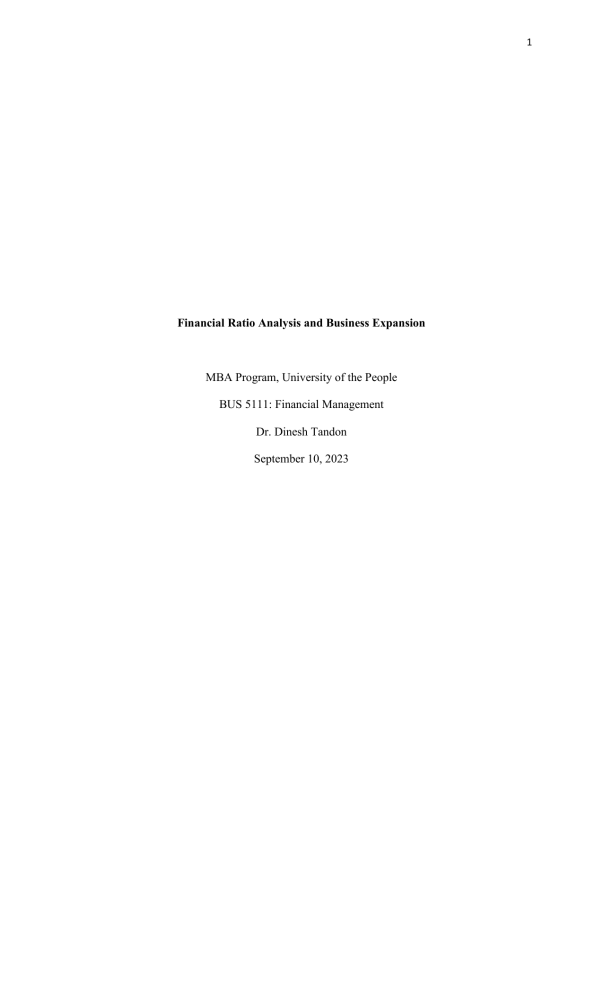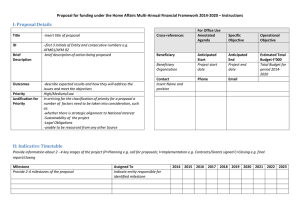
1 Financial Ratio Analysis and Business Expansion MBA Program, University of the People BUS 5111: Financial Management Dr. Dinesh Tandon September 10, 2023 2 Introduction Exceptional Service Grading Company provides services for grading, certification, and encapsulation of books usually for movie production. The company is now looking to expand to other publications such as large magazines and movie posters certifications. Financial ratio analysis will be discussed from 2017-2018 for recommendation of further strategic decisions to reach expansion goals. Financial Ratios The company’s financial position is analyzed through financial ratios and as a service company, there is no cost of goods sold like a merchandising company (Dauderis et al., 2022), but there are service contract costs in the case of Exceptional Service Grading Company. The first three ratios are listed as follows: Current ratio 2017 = 4,576,900 / 3,292,850 = 1.39 Current ratio 2018 = 5,652,200 / 3,325,950 = 1.70 Debt ratio 2017 = 4,067,900 / 5,875,400 = 69.2% Debt ratio 2018 = 4,170,300 / 7,007,800 = 59.5% Gross profit margin 2017 = 1,637,600 / 6,595,400 = 24.83% Gross profit margin 2018 = 2,696,900 / 9,200,000 = 29.31% Debt ratio is decreasing due to the increased total assets as compared to total liabilities. Current ratio and gross profit margin are increasing due to the service revenue increase and other assets acquired. Two additional ratios selected for this case are debt to equity ratio and return on equity ratio in order to analyze financial strength, performance, and return on investment (Datarails, 2023) essential for further expansion plan, listed as follows: Debt to equity ratio 2017 = 4,067,900 / 1,807,500 = 2.25057 Debt to equity ratio 2018 = 4,170,300 / 2,837,500 = 1.46971 Return on equity 2017 = 454,500 / 1,807,500 = 25.1% Return on equity 2018 = 1,330,000 / 2,837,500 = 46.9% Debt to equity ratio measures total debt as compared to shareholders’ equity of the company (BDC, 2022). Debt to equity ratio is decreasing, which is a good sign because that means liabilities are decreasing. 3 Return on equity measures a company’s profitability by comparing net income with shareholders’ equity (Acharya, 2022). Return on equity is increasing significantly, almost doubled, which means the company is growing and profitable in running their business. Trends The trends from the company’s financial statements for expansion considerations are discussed in the following. Horizontal Analysis The service contract revenues increases 39% from 6,595,400 in 2017 to 9,200,000 in 2018 affected a net income increase of 193% from 454,500 in 2017 to 1,330,000 in 2018, although this significantly resulted from other expense decrease of 85% from -63,100 in 2017 to -9,600 in 2018. Other expense decreases could result from discontinued expenses such as landscaping services, office cleaning, or snow plowing (Indeed Editorial Team, 2023) that only occurs occasionally. Vertical Analysis Dividends distribution doubled from -150,000 in 2017 to -300,000 in 2018, however the vertical percentage to the adjusted retained earnings only increases 1% from 10% in 2017 to 11% in 2018 due to the significant increase in the denominator starting from the service revenue and significant decrease in other expense as mentioned above. The 76% increase in the retained earnings ending balance from 1,357,500 in 2017 to 2,387,500 in 2018 is read differently in vertical analyses where retained earnings to the service revenue ratio is 21% in 2017 only increases to 26% due to the significant changes in service revenue and other expenses described. Recommendation With the financial position and analysis above, the company is viable for expansion to other publications such as large magazines and movie posters certifications. Although a financial projection and calculation is needed with detailed expansion costs that would be incurred for implementation. The expansion costs may include new equipment for large publications grading and certification processes, new employees to cover more work load, more office space, and information system upgrades. This plan should be presented to the board of directors for approval and implementation. Industry growth rates, interest rates, and market research are essential to build a holistic expansion plan, in addition to the expansion costs. Risk management 4 should also be formulated in the expansion and implementation plan from different vantage points (Forbes Councils Member, 2021). Follow-Up Questions for Management Financial statements’ ratio analysis limitations include incomplete holistic company information, inflation impact, accounting policy changes, operational strategy changes, and seasonal effects (CFI Team, 2023). More details are needed to calculate expansion costs to the most accurate estimate such as the costs of new equipment, new employees, additional office space, information system upgrades, and employee training. Following the industry growth rates, interest rates, and market research, these data must be analyzed for future projection to the expansion plan. Risk management plan should be discussed with the management for approval and also strategic options to different risks that may occur (Forbes Councils Member, 2021). Conclusion Exceptional Service Grading Company is growing positively with the above financial ratio analysis that makes it viable for a new project, that is, the expansion plan to grade and certify larger publications. Although more detailed information is needed to estimate the expansion plan more accurately. Expansion costs, risks, and market conditions should be gathered to create a holistic expansion plan for the company. Shareholders should be notified for approval of the expansion plan before implementation. Regular evaluation should be conducted to ensure financial strength and performance for expansion implementation success. 5 References Acharya, M. (2022, June 30). Return on Equity - Definition, Calculation and Formula of ROE. Cleartax. https://cleartax.in/s/return-on-equity-roe BDC. (2022, November 18). How to calculate the debt-to-equity ratio? BDC.ca. https://www.bdc.ca/en/articles-tools/entrepreneur-toolkit/financial-tools/debt-to-equityratio CFI Team. (2023, May 8). Limitations of ratio analysis. Corporate Finance Institute. https://corporatefinanceinstitute.com/resources/accounting/limitations-ratio-analysis/ Datarails. (2023, August 23). 5 key Financial Ratios and How to use them. https://www.datarails.com/5-key-financial-ratios/ Dauderis, H., Annand, D., Jensen, T., & Morpurgo, M. (2022). Introduction to Financial Accounting (2023A ed.). Lyryx Learning Inc. https://lyryx.com/introduction-financialaccounting/ Forbes Councils Member. (2021, February 24). 13 Key Considerations Before Expanding The Business. Forbes. https://www.forbes.com/sites/forbesbusinesscouncil/2021/02/24/13key-considerations-before-expanding-the-business/?sh=4d7d5e962906 Indeed Editorial Team. (2023, March 11). What Are Business Expenses? Definition, Types and Categories. Indeed. https://www.indeed.com/career-advice/career-development/listbusiness-expenses





